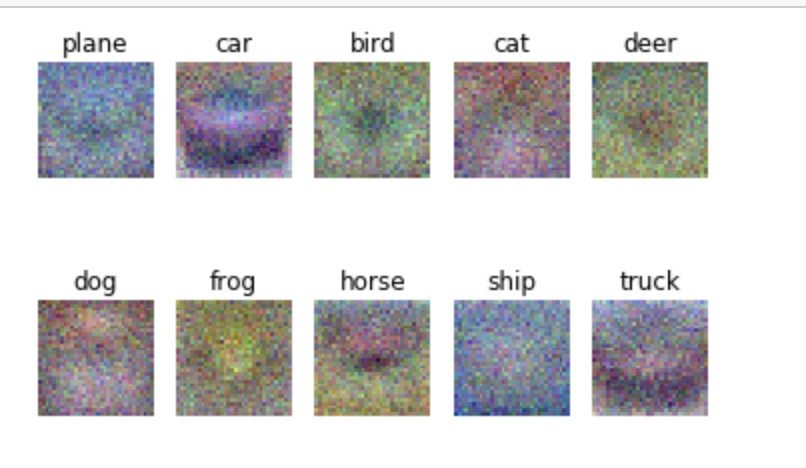Softmax
这部分主要是softmax的loss要如何计算
Assignment From: Assignment1
目标
- implement a fully-vectorized loss function for the Softmax classifier
- implement the fully-vectorized expression for its analytic gradient
- check your implementation with numerical gradient
- use a validation set to tune the learning rate and regularization strength
- optimize the loss function with SGD
- visualize the final learned weights
预处理(和之前一样(
- 载入数据
- 初始化数据
- 拉长
- normalize
- 分成训练集测试集validation等等
softmax classifier
naive_softmax_loss
中心思想:把得到的score(Wx + b)先exp,然后normalize,最后求-log
输入:
- W:大小(D,C),weights
- X:大小(N,D),输入的mini-batch
- y:大小(N,),标签
- reg:regularization的系数
输出:
- loss
- dW,即改变的gradient
计算loss
- 先将所有的scores做exp(这一步可以先进行),这样所有的score都会变成正数
- 然后对不同class的score分别求normalize(虽然说是normalize,实际求的是这个种类的score在所有的score里面所占的比例)
- 然后将正确的类型所占的比例求log,再求负号,得出来的就是每个图片的loss(这里注意0的log是无穷,计算不出来)
- 所有图片的loss求和,然后除以图片总数,regularzation,得出来的就是最终的结果
计算dW
- 可以这样理解
- W是一个参数矩阵,这个矩阵的变化由两个部分组成
- 第一部分是往什么方向变,这个取决于最后算出来的loss的分布
- 第二部分是变多少合适,这时候还需要乘一个系数X[i]
- 所以当算出来loss并且y[i] = j的时候,实际上就是这张图正确分类情况下的错误分类的概率,所以W的改变方向应该是这个的反方向
- 这张图的其他class的loss则应该是改变的方向
- W是一个参数矩阵,这个矩阵的变化由两个部分组成
- 这样就可以看出来 SVM和softmax的不同之处了
- 对于SVM来说,仅仅通过与0比大小得出一个值,相当于一个0,1的开关,只能根据结果得到一个移动的方向
- 但是对于softmax来说,不仅得到了方向,还得到了这个方向的占比,所以loss越大的数影响就会越大
1 | def svm_loss_naive(W, X, y, reg): |
softmax_loss_vectorized提高计算速度
- 跟svm部分的计算思路一样,直接使用矩阵运算
- 在求整个score矩阵的变化的时候,正确分类的loss应该被减掉,但是现在是被加上的,所以需要在正确分类的地方加一个-1
- debug了很久的地方是:计算dW的时候不需要计算log,因为没有log之前已经是这个loss所占的百分比了:求log是为了变成凸函数,loss没有求log之前并不是凸函数,但是凸函数容易找到最值的优化问问题,所以要求log。但是在计算dW的时候和log没关系
1 | def softmax_loss_vectorized(W, X, y, reg): |
验证,选hyper
和SVM的部分一样,随机搜索hyper,验证结果,训练迭代500次,最终的准确率在36%左右1
2
3
4
5
6
7
8
9
10
11
12
13
14
15
16
17
18
19
20
21
22
23
24
25
26
27
28
29
30
31
32
33
34
35
36
37
38
39
40
41
42
43
44
45
46
47# Use the validation set to tune hyperparameters (regularization strength and
# learning rate). You should experiment with different ranges for the learning
# rates and regularization strengths; if you are careful you should be able to
# get a classification accuracy of over 0.35 on the validation set.
from cs231n.classifiers import Softmax
results = {}
best_val = -1
best_softmax = None
learning_rates = [1e-7, 5e-7]
regularization_strengths = [2.5e4, 5e4]
################################################################################
# TODO: #
# Use the validation set to set the learning rate and regularization strength. #
# This should be identical to the validation that you did for the SVM; save #
# the best trained softmax classifer in best_softmax. #
################################################################################
hyper_values = np.random.rand(50,2)
hyper_values[:,0] = (learning_rates[1] - learning_rates[0]) * hyper_values[:,0] + learning_rates[0]
hyper_values[:,1] = (regularization_strengths[1] - regularization_strengths[0]) * hyper_values[:,1] + regularization_strengths[0]
for lr, rs in hyper_values:
softmax = Softmax()
softmax.train(X_train,y_train,lr,rs,num_iters = 500,verbose = True)
train_pred = softmax.predict(X_train)
train_acc = np.mean(y_train == train_pred)
val_pred = softmax.predict(X_val)
val_acc = np.mean(y_val == val_pred)
results[(lr,rs)] = (train_acc,val_acc)
if val_acc > best_val:
best_val = val_acc
best_softmax = softmax
################################################################################
# END OF YOUR CODE #
################################################################################
# Print out results.
for lr, reg in sorted(results):
train_accuracy, val_accuracy = results[(lr, reg)]
print('lr %e reg %e train accuracy: %f val accuracy: %f' % (
lr, reg, train_accuracy, val_accuracy))
print('best validation accuracy achieved during cross-validation: %f' % best_val)
可以看出来感觉softmax比SVM的效果好一些?
可视化最终的优化的weight
1 | # Visualize the learned weights for each class |
